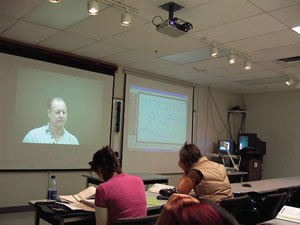A Flipped Example
- By Michael Fickes
- 11/01/14

PHOTO COURTESY OF TUCHODI
Alison Murray began her career as an industrial physicist. She decided to change careers in 2011 and became a teacher by earning an alternative certification.
She signed on to teach physics at Central Falls High School in Central Falls, R.I. Central Falls is a poor urban school that made headlines in 2010 by becoming one of the first schools to fail under the No Child Left Behind law.
When the school failed, the superintendent fired all the teachers. Murray and her colleagues came on board to rebuild the Central Falls program.
Murray used the traditional teaching model for a couple years. “My first year was about keeping my head above water and learning what my students were about,” she says.
She had heard about the flipped classroom and liked the idea. Her approach to teaching physics is to give students lots of problems to solve while she coaches. Then again, flipping a classroom required technology that Murray didn’t have, and she was teaching in a poor urban district that couldn’t afford much.
Last year, she found a way to buy the technology. She posted a classroom project request at www.DonorsChoose.org and asked for funding for a document camera and projector.
DonorsChoose is an online charity that helps public school students in need. The charity funded Murray’s request.
She bought an Epson Document Camera and an Epson BrightLink Pro projector.
The document camera not only displays live images, it records audio and video — at 30-frames per second in full resolution. It also features a 12X optical zoom and a 10X digital zoom, which makes it possible to magnify image details without distortion.
The projector throws the images captured by the camera up on the wall. A special pen interacts with the digital image field and literally writes on the air just in front of the wall. The projector can then save the images. In short, the projector can turn a wall into an interactive whiteboard.
“When I bought this equipment, I had the idea of flipping my classroom in the back of my mind,” Murray says. “I began by recording my classes. The document camera records my voice and video of my hands working out problems on paper.” Murray could work out the problems on the wall with a special pen, but that doesn’t suit her method. She prefers to work on paper under the gaze of the document camera. “I work out problems on paper just as my students would,” she says. “We do the problems together, step by step; I coach them through the process.
“I’ll ask, ‘What’s next?’ Someone will suggest multiplying by ‘m.’ Then, we’ll evaluate that. ‘Is that right? Do you agree?’”
Solving problems takes up a lot of space. If Murray used the BrightLink pen on the wall, she would quickly fill up the board and have to erase to write out the next step. With the document camera and paper, she simply moves on to another piece of paper and the camera records all the steps.
She posted the recordings online so students could review the problem-solving process.
Later she began flipping her classroom by making videos outside of class. She assigned the videos as homework and coached the students, working alone and in small groups, through similar problems the next day in class.
“Sometimes I flip a whole unit,” she says. Sometimes I work in the traditional way. Some of my classes aren’t great at homework. So I use a blend of flipped and traditional teaching. I flip more of my honors classes than non-honors. My honors kids will do the homework.”
When you think about it, that makes sense. Whether a teacher uses a traditional or flipped model or a blend of the two, the trick is to teach in a way the best engages the students.